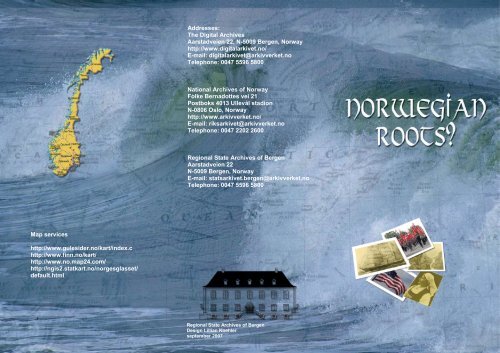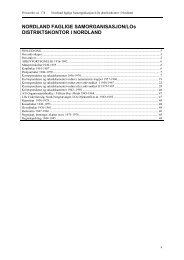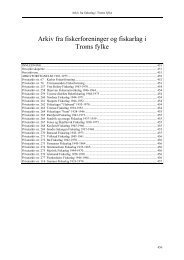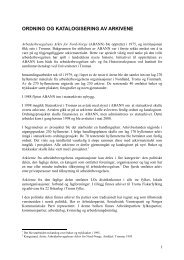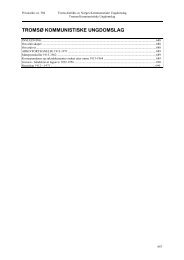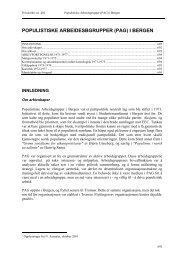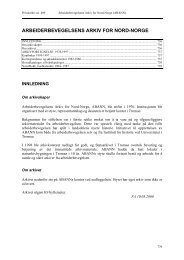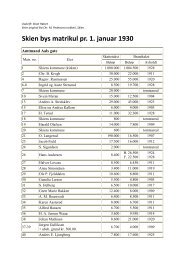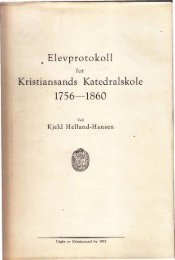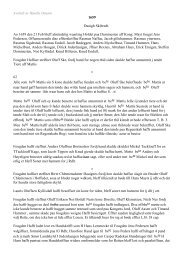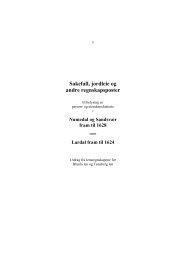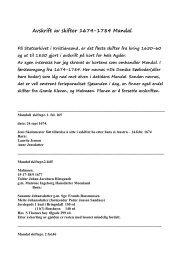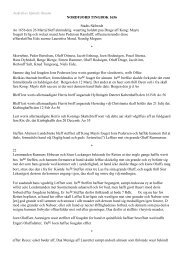The Digital Archives - brochure (PDF) - Digitalarkivet
The Digital Archives - brochure (PDF) - Digitalarkivet
The Digital Archives - brochure (PDF) - Digitalarkivet
You also want an ePaper? Increase the reach of your titles
YUMPU automatically turns print PDFs into web optimized ePapers that Google loves.
Map services<br />
http://www.gulesider.no/kart/index.c<br />
http://www.finn.no/kart/<br />
http://www.no.map24.com/<br />
http://ngis2.statkart.no/norgesglasset/<br />
default.html<br />
Addresses:<br />
<strong>The</strong> <strong>Digital</strong> <strong>Archives</strong><br />
Aarstadveien 22, N-5009 Bergen, Norway<br />
http://www.digitalarkivet.no/<br />
E-mail: digitalarkivet@arkivverket.no<br />
Telephone: 0047 5596 5800<br />
National <strong>Archives</strong> of Norway<br />
Folke Bernadottes vei 21<br />
Postboks 4013 Ullevål stadion<br />
N-0806 Oslo, Norway<br />
http://www.arkivverket.no/<br />
E-mail: riksarkivet@arkivverket.no<br />
Telephone: 0047 2202 2600<br />
Regional State <strong>Archives</strong> of Bergen<br />
Aarstadveien 22<br />
N-5009 Bergen, Norway<br />
E-mail: statsarkivet.bergen@arkivverket.no<br />
Telephone: 0047 5596 5800<br />
Regional State <strong>Archives</strong> of Bergen<br />
Design Lillian Koehler<br />
september 2007
<strong>The</strong> <strong>Digital</strong> <strong>Archives</strong> of Norway<br />
http://digitalarkivet.no<br />
<strong>The</strong> <strong>Digital</strong> <strong>Archives</strong> is a public service from the<br />
National <strong>Archives</strong> of Norway. Here you can search<br />
in transcribed source material for free. Since December<br />
1995 our databases have been available for search through the<br />
Internet, and at present more than 3800 datafiles with more<br />
than 10 million records are at hand through the <strong>Digital</strong><br />
<strong>Archives</strong>.<br />
<strong>Archives</strong> themselves are mediators of information, and the<br />
Internet provides us with new ways of letting you access our<br />
records. <strong>The</strong> <strong>Digital</strong> <strong>Archives</strong> include the Norwegian National<br />
censuses of 1801, 1865 and 1900, as well as the Norwegian<br />
emigrant databases, and lots of other records.<br />
Norwegian emigration to North America<br />
October 9, 1825 "Restauration", a tiny sloop with 53<br />
Norwegians onboard, sailed into New York harbour. <strong>The</strong><br />
vessel had been at sea for fourteen weeks on a journey from<br />
Stavanger, Norway to England and Madeira before crossing<br />
the Atlantic Ocean. It had been a hazardous trip, and the sloop<br />
was immediately confiscated by the New York authorities as it<br />
had violated regulations - being heavily overcrowded. But the<br />
"Restauration" had set an example, and within a century<br />
almost a million Norwegians followed in its wake. Of all<br />
European countries only Ireland saw a higher percentage of its<br />
people emigrate.<br />
Following the repeal of the British Navigation Laws in 1850,<br />
Canadian ports were thrown wide open to vessels of all<br />
nations. Within a few years, almost all Norwegian emigrant<br />
vessels chose Quebec as their harbour for disembarkation, and<br />
so it remained for almost 20 years. As the majority of<br />
Norwegian emigrants in the 1850s and 1860s were on their<br />
way to Illinois, Wisconsin, Iowa, or Minnesota, Quebec was a<br />
convenient harbour. <strong>The</strong> Quebec passenger lists, kept at the<br />
National <strong>Archives</strong> in Ottawa, only date back to 1865.<br />
Larger European cities such as Liverpool and Glasgow had<br />
established steamer lines to bring emigrants to America, and in<br />
1866 several steamer companies started agencies in Norway,<br />
advocating that steamers were superior to sailing vessels. <strong>The</strong><br />
steamers could cross the Atlantic in 12 to 14 days; the sailing<br />
vessels sometimes used as many weeks.<br />
In 1867, a law regulating the agencies and the emigrant trade<br />
was passed in Norway - one of the results being that the<br />
Norwegian police had to check all emigrants and register their<br />
names, place of birth, and with which line they emigrated.<br />
<strong>The</strong>se emigrant rolls are now one of the best sources to study<br />
Norwegian emigration.<br />
<strong>The</strong> year 1875 was a turning point in Norwegian emigration<br />
history: All Norwegian emigrants travelled by steamers, and<br />
all had to use foreign ships. Most of them had to travel from<br />
Norway to other European countries, in order to board. Many<br />
Norwegians travelled to Hull in England, travelled to<br />
Liverpool by train, then crossed the Atlantic from Liverpool<br />
to New York.. Almost all the steamers took their passengers<br />
to New York, where they disembarked at Ellis Island.<br />
A Norwegian emigrant line was established in 1910, and from<br />
1913 Den norske Amerikalinje (Norwegian American Line)<br />
sailed from Kristiania/Oslo and Bergen, occasionally making<br />
trips from Stavanger, Kristiansand or Trondheim. Soon, the<br />
majority of Norwegian emigrants preferred this Norwegian<br />
line, and it remained so until the end of the emigration era.<br />
How to trace your Norwegian roots<br />
1921-1930<br />
1911-1920<br />
1901-1910<br />
1891-1900<br />
1881-1890<br />
1871-1880<br />
1861-1870<br />
1851-1860<br />
1841-1850<br />
1831-1840<br />
1821-1830<br />
Norwegian Emigration 1821-1930<br />
0 20 000 40 000 60 000 80 000 100 000 120 000 140 000 160 000 180 000 200 000<br />
You may find further information on Norwegian records,<br />
institutions and how to do the research on relatives in the<br />
pamphlet "How to trace your ancestors in Norway", available<br />
on the Internet at http://digitalarkivet.no/sab/howto.html<br />
You may also find it useful if you want to know how to track<br />
down relatives who are still living in Norway.<br />
<strong>The</strong> digitised parish registers<br />
<strong>The</strong> Internet service for browsing Norwegian digitised parish<br />
registers has been available since 2005. <strong>The</strong>se registers are<br />
digitised from microfilm and then indexed, making it easy to<br />
find the first page of a register, the start of a list of records, or<br />
the start of each year in this list. From this point you can<br />
browse through the pages in the register or through a list of<br />
records, even though the records are scattered around in the<br />
original parish register. Please note, that you cannot,<br />
however, search for single records or names in the digitised<br />
material.<br />
<strong>The</strong> National <strong>Archives</strong> hold microfilm copies of almost all<br />
parish registers delivered from the parish priests’ offices to<br />
<strong>The</strong> Regional State <strong>Archives</strong>, i. e. nearly 11 000 registers<br />
with a total of 2,25 million microfilmed pages. All these<br />
microfilms will be available through the Internet by the end<br />
of 2007.<br />
<strong>The</strong> oldest Norwegian parish register dates back to 1623<br />
(Andebu, Vestfold county). <strong>The</strong> youngest parish registers,<br />
delivered and microfilmed, end in the 1970s.<br />
For the protection of privacy, there are limits for how recent<br />
published records can made available:<br />
- Birth and baptism records 1930<br />
- Confirmation records 1935<br />
- Marriage and banns records, no limits<br />
- Death, burial and stillbirth records, 80 years limit<br />
- Death and burial records without cause of death, no limits<br />
- Migration records, no limits<br />
- Joining or leavinging the State Church, 60 years limit<br />
- Records about dissenters, 60 years limit<br />
<strong>The</strong>re are no limits for marriage & banns records, death &<br />
burial records (with no causes of deaths) and migration<br />
records.<br />
<strong>The</strong> service provides permanent Internet addresses to each<br />
image of a parish register (from the image presentation<br />
page). <strong>The</strong> users are free to add links from their own Internet<br />
site to these pages. <strong>The</strong> images can also be downloaded and<br />
used in publications if one accepts the print quality of the<br />
images. In such cases, please refer to <strong>The</strong> <strong>Digital</strong> <strong>Archives</strong><br />
as source for the images.<br />
<strong>The</strong>re will later be added links between the digitised parish<br />
registers and the corresponding databases of parish registers<br />
in <strong>The</strong> <strong>Digital</strong> <strong>Archives</strong>, so one can alternate between<br />
images andtranscriptions.<br />
Over the next couple of years other records, i. e. the real<br />
estate documents of Norway up untill 1935, will be<br />
published on the Internet.


